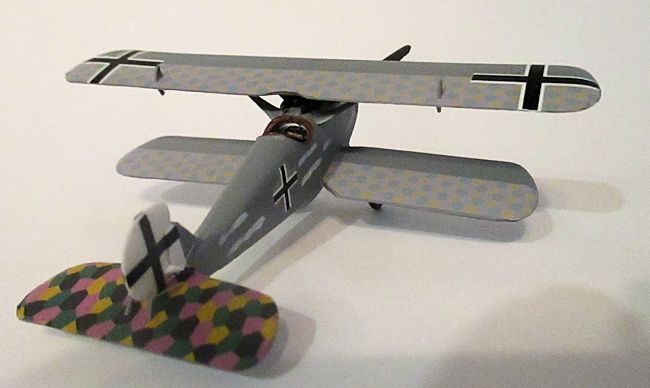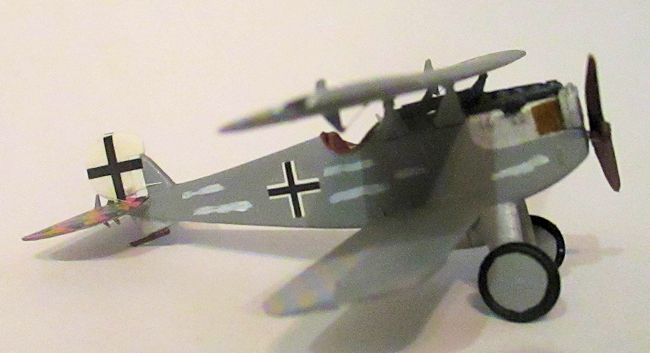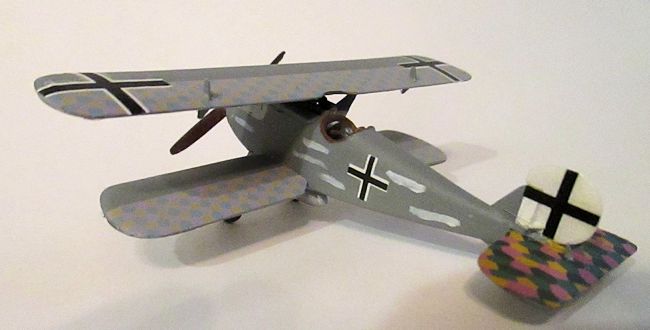
| KIT #: | 2001 |
| PRICE: | $34.00 from rare kit dealers |
| DECALS: | One option |
| REVIEWER: | Brian Baker |
| NOTES: |
Very rare kit of an
interesting subject. |

| HISTORY |
The Dornier D.1 was probably one
of the most structurally advanced airplanes to come out of World War I.
Although only six were built, the airplane was far ahead of its time in
structure, using metal torsion box
 wing spar
construction with an all metal fuselage and tail unit.
The wings were entirely cantilever. Some parts were fabric covered, but
there were no wing bracing wires, and the landing gear was at first cantilever.
Later a spreader bar was fitted.
The plane had a streamlined belly fuel tank, which could be jettisoned if
necessary. The first prototype had
a 160 hp. Mercedes DIIIA engine, while the other five had 185 BMW IIIa
powerplants.
wing spar
construction with an all metal fuselage and tail unit.
The wings were entirely cantilever. Some parts were fabric covered, but
there were no wing bracing wires, and the landing gear was at first cantilever.
Later a spreader bar was fitted.
The plane had a streamlined belly fuel tank, which could be jettisoned if
necessary. The first prototype had
a 160 hp. Mercedes DIIIA engine, while the other five had 185 BMW IIIa
powerplants.
The first prototype was destroyed during testing, which the second almost altered the course of World War II. It was first test flown by Hermann Goering, after which it was taken up by Hptm. Wilhelm Reinhard, CO of JG Richthofen, who promptly pulled the wings off, crashing to his death. Too bad Hermann wasnít flying it. This dampened official enthusiasm for the fighter during the Fighter Competition of 1918, and no more were built. Postwar, two were tested in the U.S. by the Army and Navy, and one survived in the Dornier Museum in Germany until destroyed by a bombing attack during World War II.
| THE KIT |
Cast in light grey styrene, this
is a very limited edition kit, and I believe only a few hundred were produced.
The molding looks accurate, but there is a lot of flash to be trimmed
off, and a lot of detail is
 minimal.
The cockpit consists of s floor, seat, control stick and instrument
panel, although the instructions give no indication of what should be on the
panel. There is a photo etch sheet
which provides some radiator detail, but not much mention of it in the
instructions. The wheels have
almost too much flash to be useable, although with a lot of work, they were
finally attached to the landing gear.
minimal.
The cockpit consists of s floor, seat, control stick and instrument
panel, although the instructions give no indication of what should be on the
panel. There is a photo etch sheet
which provides some radiator detail, but not much mention of it in the
instructions. The wheels have
almost too much flash to be useable, although with a lot of work, they were
finally attached to the landing gear.
In short, this is a fairly
typical short run kit, and should only be tried by someone with a lot of
experience. Most of the parts fit
fairly well, but a lot of trimming and
filler are required.
| CONSTRUCTION |
 The kit is
rather simple to assembly, given that a lot of trimming is needed.
The landing gear fits into a recess in the lower fuselage, and some putty
will take care of fit issues here.
The upper wing is mounted on four struts, which fit into the forward fuselage
structure. One of the struts on my
kit was warped somewhat, so I glued three of them onto the upper wing, and then
bent the fourth strut and attached it with superglue.
The little belly tank looked crude, but it smoothed out nicely.
The nose radiator looks good once installed, and the horizontal tail unit
fits into a slot on the tail with only a little trimming, and it is useful in
lining up the wings. The lower
wings fit into two small holes in the fuselage sides, and these should be
assembled last.
The kit is
rather simple to assembly, given that a lot of trimming is needed.
The landing gear fits into a recess in the lower fuselage, and some putty
will take care of fit issues here.
The upper wing is mounted on four struts, which fit into the forward fuselage
structure. One of the struts on my
kit was warped somewhat, so I glued three of them onto the upper wing, and then
bent the fourth strut and attached it with superglue.
The little belly tank looked crude, but it smoothed out nicely.
The nose radiator looks good once installed, and the horizontal tail unit
fits into a slot on the tail with only a little trimming, and it is useful in
lining up the wings. The lower
wings fit into two small holes in the fuselage sides, and these should be
assembled last.
| COLORS & MARKINGS |
 The
airplane has a rather strange color scheme, and a decal sheet is provided.
The fabric areas used a light lozenge pattern on top and bottom surfaces,
while the rest of the plane was pale grey.
The problem here is that there is not enough lozenge decal to cover both
wings and the tail unit, so I ended up using a different pattern for the
horizontal stabilizer and elevators, which looks funny, but beggars canít be
choosers. The decals go on easily,
and a little setting solution helped them to snuggle down on the surfaces.
There is one confusing element in the instruction sheet, as the plan view
drawings shows no lozenge pattern on the wing undersides, which would allow
enough decal for the tail unit, but there is no indication in the instructions
as to what color the wing fabric sections should be painted.
The cross decals go over the other decals, and these look very nice when
installed.
The
airplane has a rather strange color scheme, and a decal sheet is provided.
The fabric areas used a light lozenge pattern on top and bottom surfaces,
while the rest of the plane was pale grey.
The problem here is that there is not enough lozenge decal to cover both
wings and the tail unit, so I ended up using a different pattern for the
horizontal stabilizer and elevators, which looks funny, but beggars canít be
choosers. The decals go on easily,
and a little setting solution helped them to snuggle down on the surfaces.
There is one confusing element in the instruction sheet, as the plan view
drawings shows no lozenge pattern on the wing undersides, which would allow
enough decal for the tail unit, but there is no indication in the instructions
as to what color the wing fabric sections should be painted.
The cross decals go over the other decals, and these look very nice when
installed.
| CONCLUSIONS |
This kit is the only one I know
of depicting this airplane, and anyone wanting a 1/72 Dornier D.1 in his World
War I collection should not pass up this issue. The online prices seem high, but
this is the only show in town, but it is probably available at swap meets, where
I got mine. In any event, get one
and do the work. It is worth it.
July 2015 If you would like your product reviewed fairly and
fairly quickly, please
contact
the editor or see other details in the
Note to
Contributors.